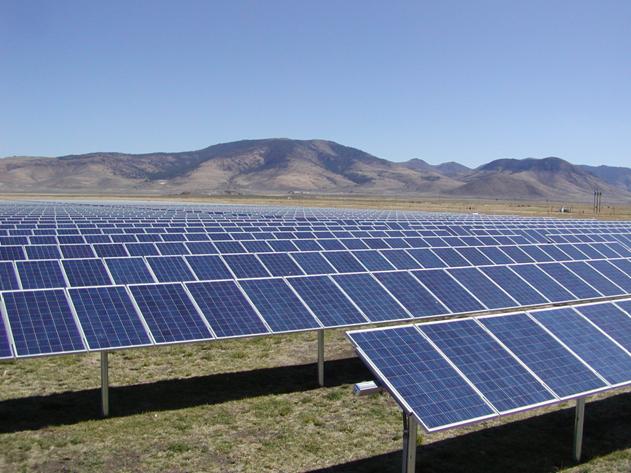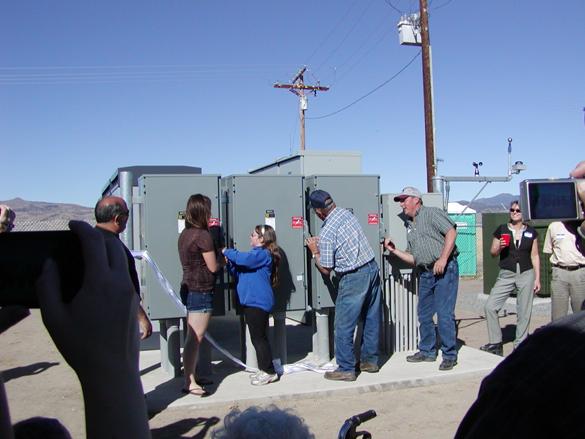Large Scale Agricultural

| Member Name: | Dave Roberti |
| Project Title: | Roberti Ranch |
| City & State: | Beckwourth, CA |
| Rated AC Output: | Approx. 500 kW (.5 Megawatt) |
| Modules: | 2,418 Trina TSM-240PA05 (240 Watts each) |
| Inverters: | 1 SMA Sunny Central SC500U-480 |
| Monitoring: | SMA Sunny Webbox |
| Total installed cost: | Approx. $2,200,000 |
| Rebate amount: | $12,000 (through Plumas Sierra Rural Elec. Co-op) |
| USDA Agriculural Grant: | $205,000 |
| USDA Agriculural Grant:: | $660,000 |
| Net Cost: | $1,323,000 |
| Net Cost per Watt: | $3.42/w, D/C & $3.97/w, A/C |
| Date of Installation: | October, 2011 |
| Designer: | Erin McMahon & Dan Pellegrini |
| Field Rep: | Dan Pellegrini |
| Installer: | Arraycon, Inc. |
For live monitoring of the Solar PV Output, click here
Overview
Dave Roberti, wanted to reduce operating expenses and “do the right thing” on his farm, Roberti Ranch, where they grow hay and raise cattle. The farm was established in 1923 by Dave’s grandmother, and now consists of over 6,000 acres, with about 400 heads of cattle and 8,000 tons of hay produced each year.
System Specifics
CCEnergy was chosen to install a PV system designed to produce enough electricity to power the 10 100-horsepower irrigation pumps at the ranch, thereby eliminating one of the main operating expenses on the farm.
The total rated DC output of the system is 580,230 watts, consisting of 2418 Trina 240w modules. The modules are mounted on single-axis trackers, which boosts the output of the array by over 25%. An SMA SC500U-480 500kW inverter is used to convert the DC output to AC. The module array covers approximately 3.38 acres.
The single-axis trackers are attached to 17’ Schedule 40 pipes driven 13’ vertically into the ground using a vibratory pile driver. This method minimizes environmental impacts by avoiding the use of concrete, with its high embedded energy and significant disposal issues. At the end of the project life cycle, the pilings can be removed by using the same vibratory equipment to pull them out of the ground; the steel is readily recyclable. The modules will be mounted 4’ above the ground so that goats or sheep can graze under the array periodically to keep the grass and weeds down.
Financial Payback
The value of the energy produced by the array is approximately $132,000 per year. Roberti Ranch qualified for a USDA grant - - with this savings, plus depreciation, the system will pay for itself in about 8 years. The expected return on investment for this project, over 30 years, is 16.9%.
Motivators
Dave Roberti’s biggest motivator for moving forward with the project was as a solid investment. Another motivator was to have a hedge against future price hikes by the electric utility company; the security of not being at the whim of electricity prices adds strength to his operations.
Dave said, in August of 2011, "When the system goes online, we'll be producing power for just about what our retail rates are. It's a no-brainer. In about 10 years [without the USDA grant], the system will be paid off. I'm trading payments to my utility for payments on an equipment mortgage. The difference is, there's a payoff on the equipment."
Environmental Stewardship
The power generated by the solar array will offset approx. 635 metric tons of CO2 per year. This is like eliminating the emissions of 100 cars driving 13,000 miles/year each in the US. Environmental stewardship is important for all of us, and makes perfect sense for those involved in Agriculture, because of the close ties to the land.
Financial considerations were Dave’s first priority. Once he was convinced this was a good investment, the positive feelings associated with generating clean, renewable energy, on his own property became more tangible.
Other Technology Considered
Wind was considered, but solar provided a better return on investment.
"Originally, we looked at wind power because we thought we were in a windy spot. But instead, at 5,000 feet, we found we're in an ideal location for solar energy production year-round, even when it's cold and snowy. After we ran the complete analysis, we found solar gave us the best bang for the buck," said Dave Roberti.
Rebate & Incentives
Roberti Ranch was eligible for a $12,000 rebate through their electric utility, Plumas Sierra Rural Electric Cooperative. Even without rebates, the financial numbers were very attractive and demonstrate the financial strength of solar.
A USDA Agricultural Grant was used to offset $205,000 of the purchase price.
Roberti Ranch also took full advantage of the 30% federal solar tax credit.
Financing
The PV system was financed through a series of loans from Tri-Counties Bank.
Conclusion
Dave feels a sense of excitement and pride associated with being the first person in his area to own and operate a solar PV system of this size. He meets people on a daily basis who are impressed and want to know more about the specifics of the technology, and the financial payback. He feels that generating power from sunlight is inherently cool. The most important piece of advice Dave would give to his peers in the agricultural industry is to stop waiting and find a way to do it!

Three generations of Roberti's switch on solar power
